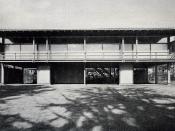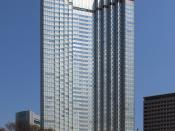Introduction According to the Maslowáæs Hierarchy, shelter is one of the survival need throughout history, but as time passes by, buildings have variety of usages, and eventually some professionals are require to help satisfy what people want, which are called architects. Architect is someone who has the potential skills and knowledge in understanding the structure of a building; his or her occupations are to take charge and design the construction of buildings, and the most important is to make sure the building is safe and durable. Architecture has several different definitions; it can be a product, a method or style used to design unique buildings. Nowadays, architects have to consider a lot more compare to the pass, such as the appearance of the building, the environments surround it, and also tonnes of legislations to follow. The famous architect that is going to be informed is Kenzo Tange.
Architectáæs Background In 1913, Kenzo Tange was born in Osaka, Japan.
He graduated from the University of Tokyo in 1938, he studied city planning, received a degree in engineering in 1959. He set up Kenzo Tange Associates with Urtec two years later. From 1963 to 1974, He served as a professor of urban engineering at the University of Tokyo. Also, he has been a guest professor at Massachusetts Institute of Technology, a lecturer at Harvard, Yale, Princeton, Washington University, Illinois Institute of Technology, the Universities of Toronto, Alabama, and California. Tangeáæs early designs combined modernism with traditional Japanese forms of architecture. In the late 1960s, he rejected the abstract international style. Obviously his styles have been transformed over time, but he has harmoniously generated his designs based on a clear structural order.
Kenzo Tangeáæs Attribution Tange had his theories, which are áçcylinders house staircase, elevators, air conditioning and electrical equipment systems. The horizontal...


